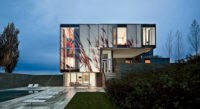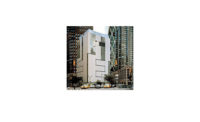Dutchess County Guest House by Allied Works
Dutchess County, New York

Photo © Hélène Binet

Photo © Dean Kaufman

Photo © Jeremy Bitterman

Photo © Jeremy Bitterman

Photo © Hélène Binet

Photo © Hélène Binet

Photo © Alejo Bague

Photo © Alejo Bague








Architects & Firms
Not surprisingly, enlisting dramatic means to frame the landscape has obsessed any number of architects over the centuries. Windows, colonnades, arcades, loggias, and pergolas all represent architectural interventions that heighten the perception of the landscape for its observers.
Due to periodic flooding, the three living pavilions rest on a platform over the site, a former garden.
Additional Content:
Jump to credits & specifications
While early Modernists, such as Le Corbusier, Rudolph Schindler, and Richard Neutra, demonstrated how linear structural elements could achieve this framing effect with a minimum of materials, Brad Cloepfil, of Allied Works Architecture, takes this impulse to an even more abstract level. For a 1,300-square-foot guest house in Dutchess County, New York, he designed a linear, 8-by-8-inch square-tube steel frame to contain the single-story volumes of a two-bedroom cottage, and continued it outdoors to demarcate the forest setting. Cloepfil enclosed the walls of the structure with santos mahogany and clear low-E glass so that the building fits chameleonlike into its thicket of oak, hickory, and birch trees. Mahogany continues on the roof plane as well, since it will be visible from the main house (also designed by Cloepfil) being built on a hill to the west.
The clients, a married couple who collect art, wanted the guest house to be somewhat near their weekend home, yet still afford all parties a sense of privacy. Perched on a small rise, the rectilinear structure’s living and sleeping areas face east, where they overlook a meandering creek.
By conceiving the guest house as a series of six rectilinear bays, four of which are 23 by 21 feet, the other two, 23 by 13 feet, Cloepfil and his team from his New York City office created an open, boxlike steel frame that rests on poured-in-place-concrete foundation walls. The frame acts as a continuous interlocking cantilever that runs along the ground and roof, with seven columns placed at diagonally opposite corners of each bay, to allow views to open up from within. This perceptual exercise can be read most clearly at the terminating bays, which are not enclosed: The frame adjoining the north end of the living room hovers above the grassy ground, while at the south end, the cantilevered outdoor frame adjoining the master bedroom delineates an imaginary ceiling. The ground cover, a thick growth of ferns and grasses, installed by landscape architect Michael Van Valkenburgh Associates, provides the “carpet.”
Detailing the joints of the steel frame and wood panels for moisture and extreme temperatures proved “intense,” in the words of the lead architect for the project, Kyle Lommen. Since the steel frame would be exposed outside, the architects needed to avoid thermal transfer and condensation within. They designed the columns so they are not contiguous but have a thermal break, preventing cold temperatures from being conveyed to the interior. With the horizontal beams that run on the floor and ceiling, the architects had to devise strategies for heating the structure inside so there would be no thermal bridging, and hence no condensation.
The attention to craftsmanship that extends throughout the guest house can be seen in the design of the oak cabinetry, which, along with the house’s simplicity, scale, and size, handsomely evokes its early Modern architectural predecessors. The choice of materials, such as slate and mahogany floors, and the interiors by Lisa Frazar Design, provide a calm setting for the art on display, which includes paintings by Mel Bochner and Adam McEwen. A concrete entry bridge by Lawrence Weiner sets the tone for the experience.
But it is the framing of the views that rivets the observer’s attention. Not only is the natural setting delineated—as would be expected—by virtue of expansive glass panels held within mahogany mullions, but the exterior steel framing elements limn smaller glimpses of nature. The hierarchies of private, semi-private, semi-open, and open spaces become so integral to the perceptual experience that no matter where you are sitting in the house, you have the view, as well as the view within the view.
PeopleArchitect: Allied Works Architecture, Inc. Principal: Brad Cloepfil, AIA Project Lead: Kyle Lommen Project Architect: John Clappi, Dori Raskin Project Team: Daniel Richmond, Aron Himmelfarb
Interior designer: Lisa Frazar Design LLC
Consultant(s): Curtain Wall: R.A. Heintges & Associates Landscape: Michael Van Valkenburgh Associates, Inc. Lighting: George Sexton Associates MEP: Tucker Associates Consulting Engineers Structural: Robert Silman Associates
General contractor: Berkshire Wilton Partners, LLC
Photographer(s) Hélène Binet Dean Kaufman Jeremy Bittermann
CAD system, project management, or other software used: VectorWorks
|
ProductsStructural system Steel Frame Wood Infill
Exterior cladding Steel frame finish: Tnemec paint Wood: Santos mahogany (manufacturer unknown)
Roofing Fluid applied membrane roofing: Decothane by LiquidPlastics
Windows Wood: Dynamic Architectural Windows and Doors
Doors Wood entrance doors: Dynamic Architectural Windows and Doors Interior wood doors: St. John’s Bridge Exterior sliding doors: Dynamic Architectural Windows and Doors
Hardware Hinges Rixson Door knobs Nanz Cabinet hardware: Hafele
Interior finishes Cabinetwork and custom woodwork: Custom cabinetry: St. John’s Bridge Paints and stains: Benjamin Moore Paneling: Wood wall panels: St. John’s Bridge Special surfacing: Floor and wall tile Stone floor in mudroom: Stone Source Wall and floor tile in bathrooms: Ann Sacks
Furnishings Beds: Custom design by Allied Works Architecture
Lighting Interior lighting: Litelab Exterior decklights: Illumiscape
Plumbing Vola faucets throughout |













